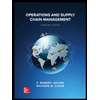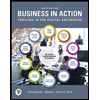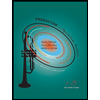
Business in Action Plus MyLab Intro to Business with Pearson eText -- Access Card Package (8th Edition)
8th Edition
ISBN: 9780134473642
Author: Courtland L. Bovee, John V. Thill
Publisher: PEARSON
expand_more
expand_more
format_list_bulleted
Question
Chapter 19, Problem 14QAP
Summary Introduction
To discuss: The form of investment that the investors are required to seek and the reason for it when they need a constant and a predictable cash flow.
Expert Solution & Answer
Want to see the full answer?
Check out a sample textbook solution
Students have asked these similar questions
Factor Factor Description
Weight
Present Location Newbury
Hyde Park
1
Average community income
0.35
2
Community growth potential
0.15
3
Availability of public transportation
0.20
4
Labor availability, attitude, and cost
0.30
3 2 3 2
35
20
25
75
33 28
55
55
25
75
65
50
50
55
Subway with more than 27,000 outlets in the US is planning for a new restaurant in Buffalo New York.
A) Based on the given information, the best location in Buffalo for Subway to open the new restaurant is Baptist Church with a total weighted score of? (Enter your response rounded to two decimal places.)
B) If the weights for Space and Traffic density are reversed, the best location in Buffalo for Subway to open the new restaurant will be with a total weighted score of ? (Enter your response rounded to two decimal places.)
northeastern insurance company is considering opening an office in the US. The two cities under consideration are going to be Philadelphia New York. Factor ratings (higher scores are better) are in the table.
The best location for northeastern insurance company to open would be which with a total weighted score of ? (response rounded to two decimal places)
Chapter 19 Solutions
Business in Action Plus MyLab Intro to Business with Pearson eText -- Access Card Package (8th Edition)
Ch. 19.1 - Prob. 1CTCh. 19.1 - Prob. 2CTCh. 19.1 - Prob. 1IYBCh. 19.2 - Prob. 1CTCh. 19.2 - Prob. 2CTCh. 19.2 - Prob. 1IYBCh. 19.2 - Prob. 2IYBCh. 19.3 - Prob. 1CTCh. 19.3 - Prob. 2CTCh. 19.3 - Prob. 1IYB
Ch. 19.3 - Prob. 2IYBCh. 19.4 - Prob. 1CTCh. 19.4 - Prob. 2CTCh. 19.5 - Prob. 2CTCh. 19.5 - Prob. 1IYBCh. 19.6 - Prob. 1IYBCh. 19.6 - Prob. 2IYBCh. 19 - Prob. 4QRCh. 19 - Prob. 5QRCh. 19 - Prob. 6QRCh. 19 - Prob. 7QRCh. 19 - Prob. 8QRCh. 19 - Prob. 9QACh. 19 - Prob. 10QACh. 19 - Prob. 11QACh. 19 - Prob. 12QACh. 19 - Prob. 13QACh. 19 - Prob. 14QAPCh. 19 - Prob. 15QAPCh. 19 - Prob. 16QAPCh. 19 - Prob. 17QAPCh. 19 - Prob. 18DCOCh. 19 - Prob. 19DCOCh. 19 - Prob. 20DCOCh. 19 - Prob. 1ITICh. 19 - Prob. 21SCSCh. 19 - Prob. 22SCSCh. 19 - Prob. 1BTSCh. 19 - Prob. 24DRS
Knowledge Booster
Similar questions
- When football fans watch a game, they believe the other side commits more infractions on the field than does their own team. This favoritism can best be termed _____. Group of answer choices A. ethnocentrism B. the fundamental attribution error C. the affiliation bias D. marginalizationarrow_forwardWhen football fans watch a game, they believe the other side commits more infractions on the field than does their own team. This favoritism can best be termed _____. Group of answer choices ethnocentrism the fundamental attribution error the affiliation bias marginalizationarrow_forwardWhich of the following best describes the differences between egalitarianism and hierarchy as cultural values in negotiation? Group of answer choices A. Egalitarian cultures communicate directly; hierarchical cultures communicate indirectly. B. Egalitarian cultures treat people equally; hierarchical cultures discriminate among people. C. Egalitarian cultures divide things equally; hierarchical cultures divide things according to merit and status. D. Egalitarian cultures believe that status is permeable through effort and achievement; hierarchical cultures believe that superiors should take care of the needs of subordinates.arrow_forward
- Which of the following best describes the differences between individualism and collectivism as cultural values in negotiation? Group of answer choices A. Individualists see themselves as autonomous entities; collectivists see themselves in relation to others. B. Individualists prefer to work in groups; collectivists prefer to work alone. C. Individualists are cooperative; collectivists are competitive. D. Individualists focus on relationships; collectivists focus on money.arrow_forwardWhen it comes to resolving conflict, managers from hierarchical cultures prefer _____. Group of answer choices A. to attribute a disagreeable person's behavior to an underlying disposition and desire formal dispute resolution procedures B. an interests model that relies on resolving underlying conflicts C. to regulate behavior via public shaming D. to defer to a higher status personarrow_forwardThe tripartite model of culture is based on three cultural prototypes that represent negotiators’ self-views and are highly correlated with particular geographic regions. Give an example of the three. Face Dignity Honorarrow_forward
- The personality and unique character of a social group is best known as its _____ and includes the values and norms shared by its members and encompasses the structure of its social, political, economic, and religious institutions. Group of answer choices group identity group potency group stereotype culturearrow_forwardagree or disagree with this post Face - “Face” or dignity in a negotiation has been called “one of an individual’s most sacred possessions.”102 Face is the value a person places on his or her public image, reputation, and status vis-à-vis other people in the negotiation. Direct threats to face in a negotiation include making ultimatums, criticisms, challenges, and insults (Thompson, 2019). A good example of face is when I go to the negotiation table with a counterpart that is known to be difficult or not as knowledgeable about the category as they should be, my approach wouldn't be to point out their weakness, I will respect their thought process, show consideration for their perspective, all while guiding the conversation in the direction of my intended negotiation strategy in hopes to achieve my desired outcome. Dignity - endorses views such as, “People should stand up for what they believe in, even when others disagree,” and “How much a person respects oneself is far more…arrow_forward16:53 ◄ Mail 5G CSTUDY_Jan25_SCMH_O...Final_20250220143201.pdf CHOOSING FORECASTING MODELS gradienting are more mode. Yet when selecting a forecasting method, the door forecasts in fact, each of the three methods has different strength and can play important ing importance of the factors, such as the index and cast model, or a unified approach, ch del runs individual series separately A galable manufacturer is facing changes with demand fuctuations due to economiyapply make changes. Comment on why this has been the case and propose a forecasting approach that can be utilised t Question 13 ashit from a batch production process to a continuous flows to enhance efficiency. Critically analyse the trade- A public hospital in Free State is experiencing increasing patient wait times due to limited operacity. The hospital management is considering either expanding existing facilities orating more efficient Question 1.5 A farming consponsible for planting grain crops in Free State As expected…arrow_forward
- How can a college basketball coach use lean system strategies to improve the team's performance and win the national championship? What wastes can be eliminated from the team's training and equipment? How can performance data be used to adjust the team's strategy and tactics?arrow_forwardHow much does self-awareness influence the Interpersonal Trust Scale's results?arrow_forwardWhich of the following statements about organization's strategy is FALSE? OA. They are formulated after the organization's mission is determined. OB. They reflect an organization's purpose. OC. An organization's strategy exploits opportunities and threats. OD. They help determine how an organization expects to achieve its miss OE. Each functional area of the organization will have a strategy. The ability of an organization to match changes in a marketplace where design volumes fluctuate substantially is: OA. competing on productivity. OB. mass production. OC. time-based competition. OD. competing on differentiation. O E. competing on response. Porter's Five Forces Model is used to evaluate competition based on which 5 asp A. immediate rivals, potential entrants, customers, suppliers, and substitute B. potential entrants, customers, suppliers, legal regulations, and costarrow_forward
arrow_back_ios
SEE MORE QUESTIONS
arrow_forward_ios
Recommended textbooks for you
 Practical Management ScienceOperations ManagementISBN:9781337406659Author:WINSTON, Wayne L.Publisher:Cengage,
Practical Management ScienceOperations ManagementISBN:9781337406659Author:WINSTON, Wayne L.Publisher:Cengage, Operations ManagementOperations ManagementISBN:9781259667473Author:William J StevensonPublisher:McGraw-Hill Education
Operations ManagementOperations ManagementISBN:9781259667473Author:William J StevensonPublisher:McGraw-Hill Education Operations and Supply Chain Management (Mcgraw-hi...Operations ManagementISBN:9781259666100Author:F. Robert Jacobs, Richard B ChasePublisher:McGraw-Hill Education
Operations and Supply Chain Management (Mcgraw-hi...Operations ManagementISBN:9781259666100Author:F. Robert Jacobs, Richard B ChasePublisher:McGraw-Hill Education
 Purchasing and Supply Chain ManagementOperations ManagementISBN:9781285869681Author:Robert M. Monczka, Robert B. Handfield, Larry C. Giunipero, James L. PattersonPublisher:Cengage Learning
Purchasing and Supply Chain ManagementOperations ManagementISBN:9781285869681Author:Robert M. Monczka, Robert B. Handfield, Larry C. Giunipero, James L. PattersonPublisher:Cengage Learning Production and Operations Analysis, Seventh Editi...Operations ManagementISBN:9781478623069Author:Steven Nahmias, Tava Lennon OlsenPublisher:Waveland Press, Inc.
Production and Operations Analysis, Seventh Editi...Operations ManagementISBN:9781478623069Author:Steven Nahmias, Tava Lennon OlsenPublisher:Waveland Press, Inc.

Practical Management Science
Operations Management
ISBN:9781337406659
Author:WINSTON, Wayne L.
Publisher:Cengage,

Operations Management
Operations Management
ISBN:9781259667473
Author:William J Stevenson
Publisher:McGraw-Hill Education

Operations and Supply Chain Management (Mcgraw-hi...
Operations Management
ISBN:9781259666100
Author:F. Robert Jacobs, Richard B Chase
Publisher:McGraw-Hill Education


Purchasing and Supply Chain Management
Operations Management
ISBN:9781285869681
Author:Robert M. Monczka, Robert B. Handfield, Larry C. Giunipero, James L. Patterson
Publisher:Cengage Learning

Production and Operations Analysis, Seventh Editi...
Operations Management
ISBN:9781478623069
Author:Steven Nahmias, Tava Lennon Olsen
Publisher:Waveland Press, Inc.